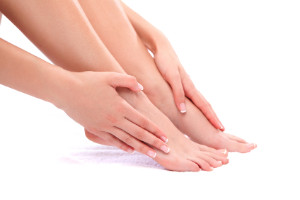What Are the Symptoms of Cuboid Syndrome?
Monday, 02 November 2020 00:00 Pain that is felt on the outside of the foot may be indicative of cuboid syndrome. The cuboid bone may become displaced as a result of a sudden injury, or it may gradually become displaced from repetitive overuse. The symptoms that are often associated with this condition can include pain and weakness which can be felt on the outside of the ankle. Additionally, the area may appear to be bruised and swollen, and it can be difficult to walk. The healing process can begin with performing specific stretches that may help to realign the affected joints. If you are experiencing pain in this part of your foot, it is strongly recommended that you consult with a podiatrist who can properly diagnose and treat this condition.
Pain that is felt on the outside of the foot may be indicative of cuboid syndrome. The cuboid bone may become displaced as a result of a sudden injury, or it may gradually become displaced from repetitive overuse. The symptoms that are often associated with this condition can include pain and weakness which can be felt on the outside of the ankle. Additionally, the area may appear to be bruised and swollen, and it can be difficult to walk. The healing process can begin with performing specific stretches that may help to realign the affected joints. If you are experiencing pain in this part of your foot, it is strongly recommended that you consult with a podiatrist who can properly diagnose and treat this condition.
Cuboid syndrome, also known as cuboid subluxation, occurs when the joints and ligaments near the cuboid bone in the foot become torn. If you have cuboid syndrome, consult with Dr. Steven Schwartz from Pennsylvania. Our doctor will assess your condition and provide you with quality foot and ankle treatment.
Cuboid syndrome is a common cause of lateral foot pain, which is pain on the outside of the foot. The condition may happen suddenly due to an ankle sprain, or it may develop slowly overtime from repetitive tension through the bone and surrounding structures.
Causes
The most common causes of cuboid syndrome include:
- Injury – The most common cause of this ailment is an ankle sprain.
- Repetitive Strain – Tension placed through the peroneus longus muscle from repetitive activities such as jumping and running may cause excessive traction on the bone causing it to sublux.
- Altered Foot Biomechanics – Most people suffering from cuboid subluxation have flat feet.
Symptoms
A common symptom of cuboid syndrome is pain along the outside of the foot which can be felt in the ankle and toes. This pain may create walking difficulties and may cause those with the condition to walk with a limp.
Diagnosis
Diagnosis of cuboid syndrome is often difficult, and it is often misdiagnosed. X-rays, MRIs and CT scans often fail to properly show the cuboid subluxation. Although there isn’t a specific test used to diagnose cuboid syndrome, your podiatrist will usually check if pain is felt while pressing firmly on the cuboid bone of your foot.
Treatment
Just as the range of causes varies widely, so do treatments. Some more common treatments are ice therapy, rest, exercise, taping, and orthotics.
If you have any questions, please feel free to contact our offices located in Chambersburg, and Mcconnellsburg, PA . We offer the newest diagnostic and treatment technologies for all your foot care needs.

